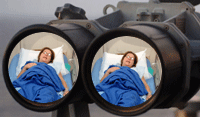Medicine Meets Miniaturization

There Must Be
A Better Way
Like some modern day Alice in Wonderland, medical imaging technology races further down the rabbit hole of miniaturization. What previously would have been ludicrous to consider even in our dreams is quickly becoming reality.
The latest advance, announced in the current issue of Nature by scientists from Massachusetts General Hospital, is the Spectral Encoded Miniature Endoscope - a bit of a mouthful, to be sure, and will henceforth be referred to by its acronym, "SEE." A significant advance in endoscopic technology, first developed over fifty years ago, SEE improves on both size and image quality. Endoscopes are long, narrow tubes with both lights and lenses attached that allow physicians to look inside the body without making an incision.
Current miniature endoscopes utilize a bundle of optical fibers and are typically about one centimeter, approximately four-tenths of an inch, in diameter. SEE uses a single optical fiber and is about the size of a human hair. Not only is the size remarkable, the images are first class. Previous imaging sensors have allowed for high-quality, two-dimensional images. SEE again ups the ante, pushing the imaging capabilities to three dimensions - in high definition.
Potential applications include fetal and pediatric procedures, as well as adult procedures requiring minimally invasive technology, such as exploration of the salivary ducts or the fallopian tubes. Scientists believe the reduced size of the SEE may allow safe access to areas of the body that were previously unreachable.
Alice would be proud.


0 Comments:
Post a Comment
<< Home